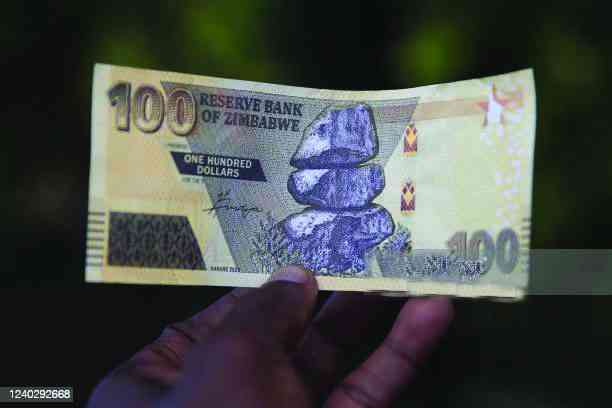
On the auction market this week, the Zimdollar pared by 28% against the greenback, its worst decline on record since its creation. The session marked its first since the promulgation of an allocation limit of US$5 million by government to the respective market. in the trading session, allocations totalled US$4.9 million against total demand of US$25 million, resulting in a supply shortfall of US$20 million. cumulatively the Zimdollar has pared by 81.3% against the US since the beginning of the year.
This has been its worst performance since the dollar’s reintroduction in 2019. Meanwhile later on Tuesday, the RBZ announced further measures to strengthen the local unit, following the Treasury’s intervention a fortnight ago.
The Bank said the interbank market will become the primary forex trading platform taking away the function from the Bank controlled Auction market.
In its first session since the measures were announced, the Interbank recorded trades amounting to US$11.2 million against bids totalling US$13 million. this shows that demand was significantly higher, which could be as a result of market realignment, since the promulgation of new measures.
Sellers are still watching the market for indications of stability and therefore are most likely to be cautious on foregoing hard currency.
On the other hand, demand has been building up given the sharp decline in auction allocation to just US$5 million this week from a prior average of US$15 million per week since the beginning of the year.
An allocation of US$11.2 million on the interbank taken together with a US$5 million allocation on the auction market gives a total of about US$17 million allocation so far this
The Monetary Policy Committee (the MPC) of the Reserve Bank of Zimbabwe (the Bank) met on 6 June 2023 and deliberated on macroeconomic and financial developments in the economy.
- Rampaging inflation hits Old Mutual . . . giant slips to $9 billion loss after tax
- Monetary measures spur exchange rate stability: RBZ
- Zim deploys IMF windfall to horticulture
- Banker demands $21m from land developer
Keep Reading
The MPC also deliberated on the progress made in the implementation of measures announced by the Honourable Minister of Finance and Economic Development on 11 May 2023 and 29 May 2023, respectively, to address the recent volatility in the exchange rate and prices of goods and services in the economy.
Further monetary policy measures
With effect from 7 June 2023, the Bank shall sell foreign currency at the market-determined exchange rate through banks.
Implication
The measure completes the shift to a market driven exchange rate system under the Willing Buyer Willing Seller Interbank system.
The decentralised system is run by banks. However, its effectiveness was limited by caps on tradeable amount per bid and its movement capped against a present rate from the latest auction.
These limits were US$100, 000 max bid and 10% movement cap against the auction.
These limits prohibited effectiveness of the respective market as a market maker as bigger players were not able to participate (demand) given the bid size allowable.
Further, the caps against the auction deterred sellers given its variance to real market rates, presumably reflected through parallel market.
Historical data shows the interbank accounted for only 2% of total external foreign currency transactions completed in 2022.
The auction market contribution was relatively higher at about 8% in the respective year.
Given the new measures we may begin to see a growth in interbank trades against diminished auction trades. It is also likely that with entrenched dollarisation own FCA utilisations will increase, thus reducing the overall contribution from both the interbank and auction.
In the latest auction, only a total of close to US$5 million was allocated against demand of over US$20 million. In successive weeks, we are likely to see the shift in demand from the auction to the interbank.
In the same statement RBZ goes on to say the auction system shall continue to operate for meeting smaller requirements for foreign payments and for continuous price discovery.
It is not clear how the failed auction system can achieve the objective of continuous price discovery even so with suppressed supply levels and a more diminished overall contribution to total trades.
If the auction market shifts in earnest from the managed Reuters system to Dutch, a shift in the bidding process, now prioritising higher bids, may result in a more market reflective rate, but with flows limited to only US$50,000, this market should not be allowed to set the rate as before, despite changed trading conditions regarding the bidding criteria.
To improve market confidence and do away with speculation and suspicion, the auction market has to be completely scrapped.
The only reason why the RBZ will choose to retain it, is to position itself for intervention, if the interbank gives “unfavourable” outcomes.
The Bank is used to managing the rate and therefore anticipation of spikes unsettles it and would want to quickly intervene in the event of unfavourable outcomes emerging.
This should not be the role of the RBZ, rather the Bank, should ensure that market distortions are removed and pure market forces are allowed to play.
Intervention by the RBZ should come in the form of market moderations through aiding supply or demand on the interbank market where volatility goes out of hand.
Removal of a 90-day liquidation requirement on export proceeds removed
The reversal measure increases dollarisation levels in the economy and comes barely a fortnight after Treasury announced its restatement.
This effectively reduces demand and utilisation of the local currency.
Exporters will however still be required to surrender 25% of their foreign currency earnings in exchange for the local currency.
Other measures
Increasing the Bank policy rate from 140% to 150% per annum, in response to the recent increase in inflation;
Increasing the Medium-term Bank Accommodation (MBA) interest rate from 70% to 75% per annum
Increasing the Statutory Reserve Requirements on local currency demand and call deposits from 10% to 15%, while maintaining savings and time deposit requirements at 5%.
The upward revision in benchmark interest rate, comes barely 3 months after a downward revision, by the same magnitude.
What is concerning about the adjustment, is whether its sufficient enough to curtail borrowing.
This concern is best looked at in terms of the inflation rate. The inflation rate has spiked significantly in Zimdollars, terms and is now nearing 700% which compared to only 200% over the period at which the previous benchmark rate was set at 150%.
This means the interest rate response is not sufficient to discourage speculative borrowing and therefore largely ineffective to influence the exchange rate. This also goes for the Medium-Term Bank rate. With banks, we are however likely to see a tactical slowdown in credit extension given suboptimal rates and raging inflationary pressure.
The growth in USD loan books, is likely to continue, but the downside of FCA driven credit growth, remains a huge risk to exchange rate stability in Zimbabwe.
- Gwenzi is a financial analyst and MD of Equity Axis, a financial media firm offering business intelligence, economic and equity research. —respect@equityaxis.net







